When the roof on the City Hall complex in Newport News, Virginia, began to fail, the city leaders had several key priorities in mind. They wanted to ensure that the new roof system would be durable and aesthetically pleasing — and that the city’s tax dollars were wisely spent. It took a team of talented roofing professionals to come up with the ideal solution.
In the end, Hound Roofing, a commercial roofing contractor headquartered in Wilmington, North Carolina, implemented a roof restoration plan that met all of the city’s needs.
The City Hall complex consists of the Main City Hall Building, the Council Chamber Building, and the Treasury Building. The project involved re-roofing all three buildings, as well as the walkways between them. In total, the roof areas encompassed some 50,000 square feet.
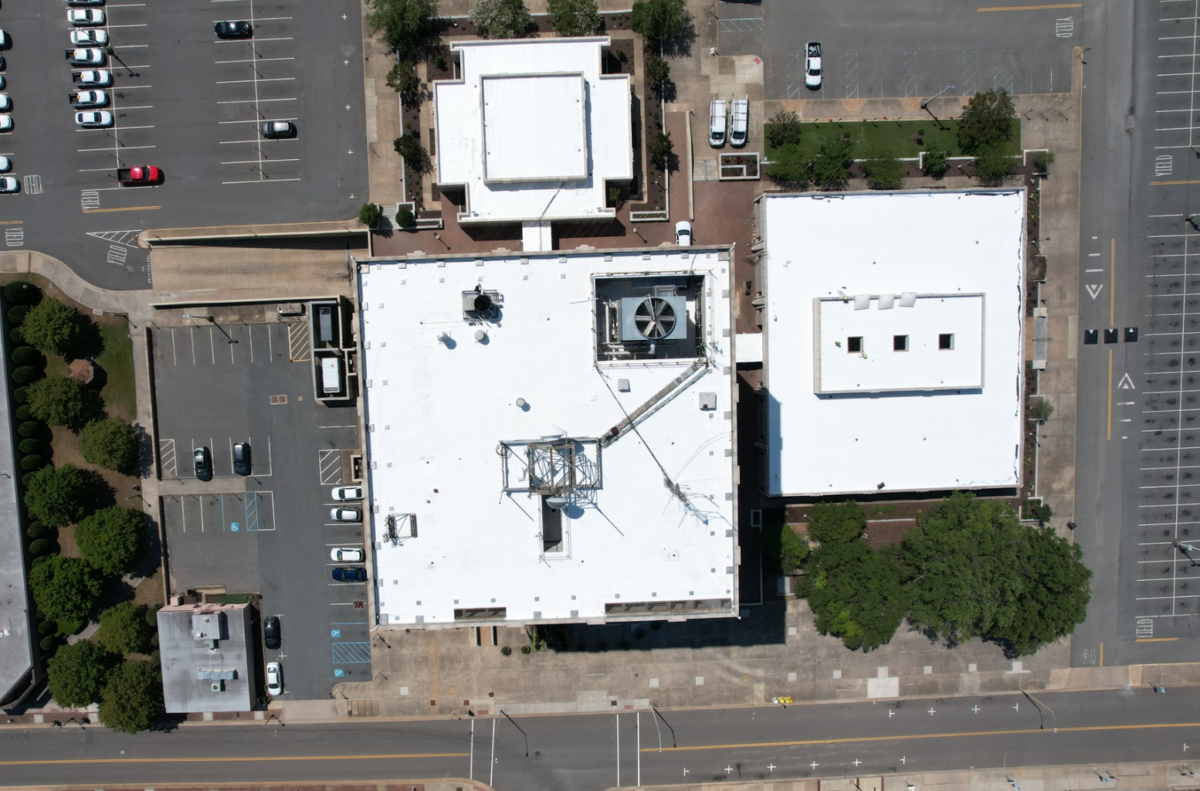
The existing roof consisted of a modified bitumen system on top of a concrete deck. After a thorough roof inspection, Hound Roofing worked with its manufactures’ representatives to develop a specification for a fabric-reinforced liquid-applied rubber coating system manufactured by Truco. Low areas would be supplemented with Soprema’s Elastophene Flam modified base sheet. The application would be cost effective and minimize disruptions — and the system offered a 20-year warranty.
“The warranty was what had them leaning toward the restoration system,” notes Anthony Wilkerson, general manager of Hound Roofing. “The city wanted a 20-year system, and we were able to supply 20-year system warranty and a two-year contractor warranty.”
Implementing the Plan
Crews from Hound Roofing began by removing and replacing wet insulation in the areas that were beyond restoration, repairing and replacing the membrane as necessary. The various roof areas were power washed to remove dirt and debris. After the roof areas were allowed to dry thoroughly, crews applied Truco Eterna-Seal 7143, a liquid-applied rubber base coat. After the first coat was dry, a second coat of Truco 7143 was then applied with RH40 fabric reinforcement. The system was topped with Truco Eterna-Seal 7140, a liquid rubber top coat.
“The base coat is gray, and for this project, the top coat was white, but you can get it in different colors,” Wilkerson notes. “I just did a metal roof with it in bright red.”
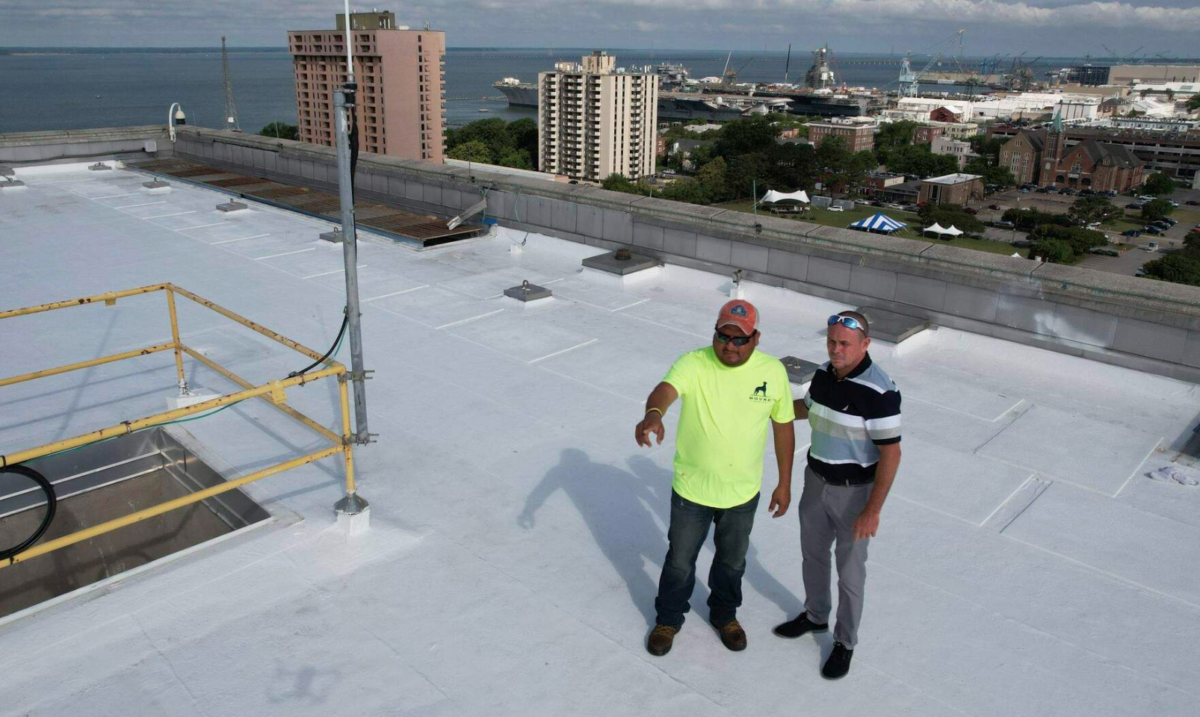
Work began on the annex buildings. “We started with one of the annex buildings, and we got it power washed and cleaned off,” Wilkerson says. “After we applied base coat, we jumped over to the other annex building, and got the base coat on over there. Before we did the final coat on the annex buildings, we moved on the main building.”
The schedule had to be adjusted to ensure no fumes were pulled into the fresh air intakes on the main building. It was a lesson learned the hard way. “When we initially began the coating process on the main building, we had to shut the building down, as the smell could be detected in the building,” Wilkerson says. “Luckily it was late in the day on a Friday. We immediately coordinated with people at City Hall. The solution we came up with was to work on the main building after 4:30 p.m. every day and on the weekends, when no one was in the building and the air intakes could be shut down.”
As the project progressed, crews worked on the annex buildings during the day, and after 4:30, they moved up to the main roof and worked there until darkness fell. As an added precaution, crews also framed temporary walls around the air intakes to make sure no fumes would enter the air intakes, even when they were turned off.
Challenging Jobsite
The schedule was complicated by inclement weather. “To install the restoration system, the temperature has to be 45 degrees and rising,” Wilkerson says. “We started the project in February, so it was still in the heart of winter. We lost about 20 days due to weather — 15 days to rain and maybe five days that were too cold.”
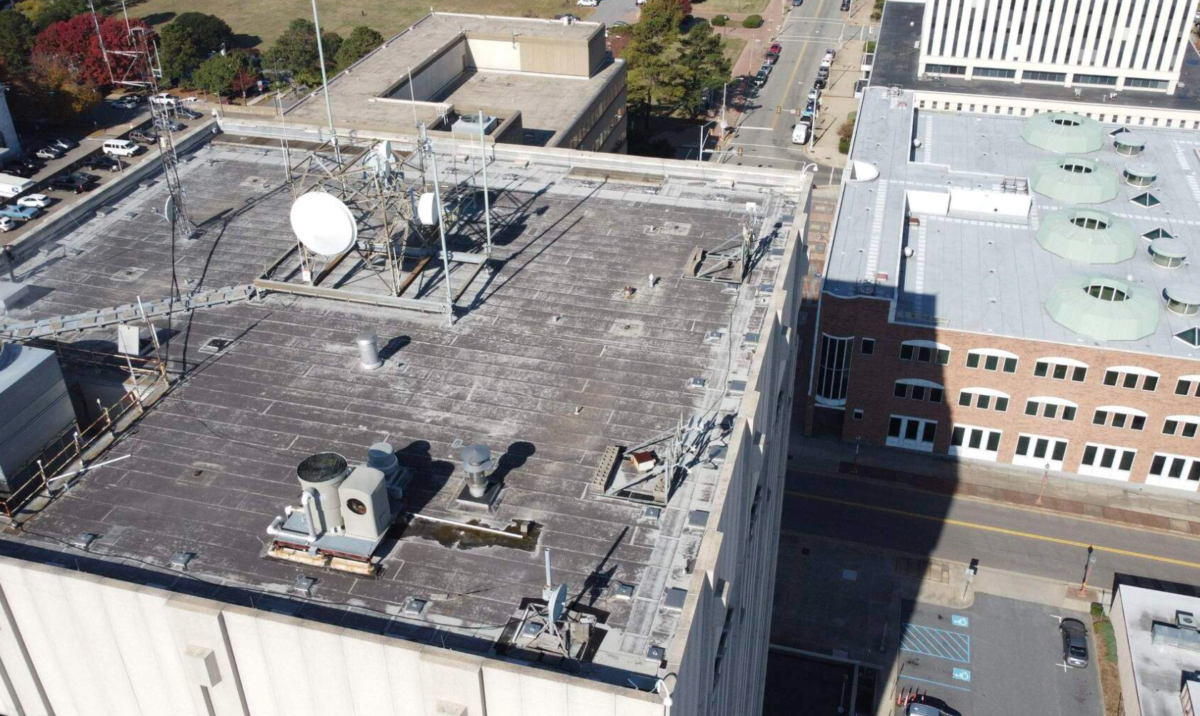
Temperature-sensitive equipment was stored in the basement to ensure it was ready to apply when the time came.
Safety concerns included fall protection for roofing crew members and protecting people entering and exiting the buildings. “The most challenging safety aspect was people walking around the buildings all day,” Wilkerson notes. “We kept the areas we were working above flagged off and had a safety monitor on the ground. We also had to get certified in asbestos training in order to work on the main building.”
The high-profile nature of the project put the company’s safety program under a microscope. “Anybody who has anything to do with safety in the city is in that main building,” Wilkerson says. “They can look right out the window and see us on those annex buildings. We flagged off the sidewalk near areas we were working and had someone on the ground directing traffic and telling pedestrians where it was safe to walk.”
Fall protection plans were set up for each roof section. “On the annex roofs, the parapet walls weren’t tall enough, so we had to use safety stands and safety lines around the annex roofs. On the main roof, the parapet walls were over 42 inches, so we didn’t have to have fall protection equipment there.”
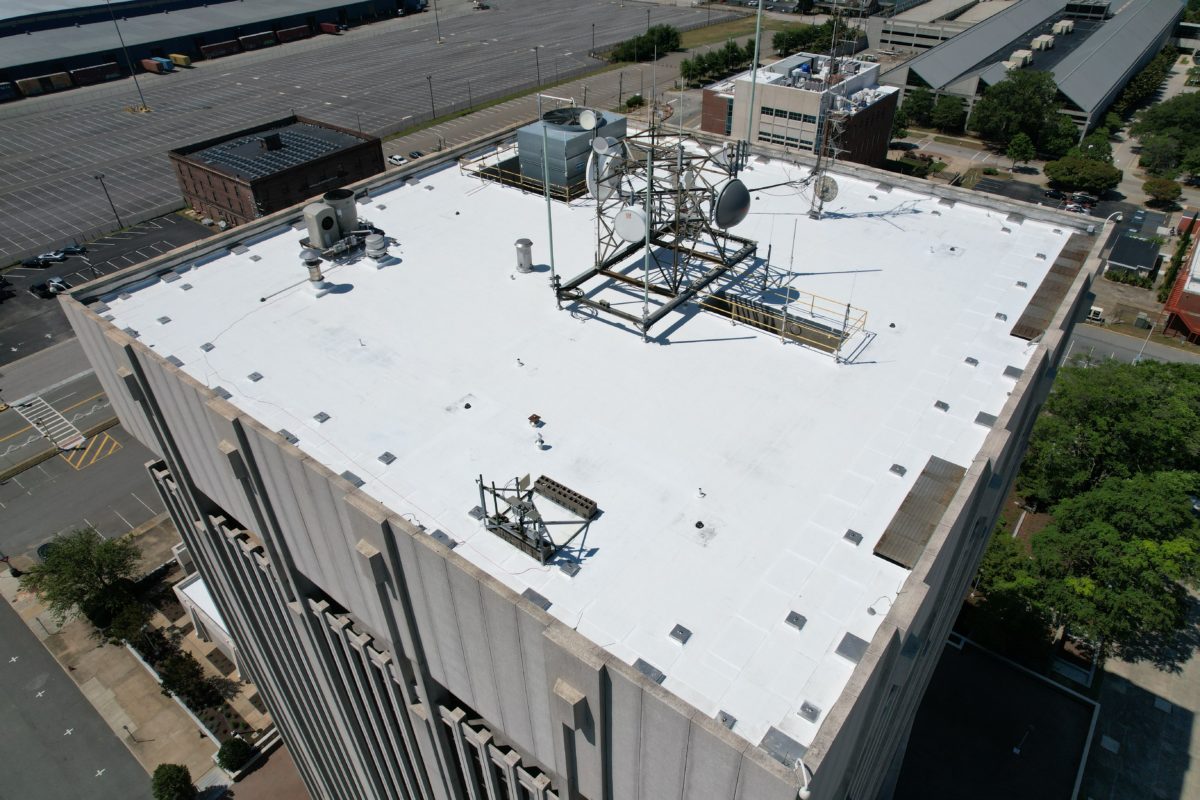
The walkways to the annex buildings posed some challenges. “On the walkways, there was no place to really tie off correctly, so we had to make our own temporary tie-off points in certain areas and move them as work progressed. We did the walkways on the weekends to make sure there was no foot traffic below.”
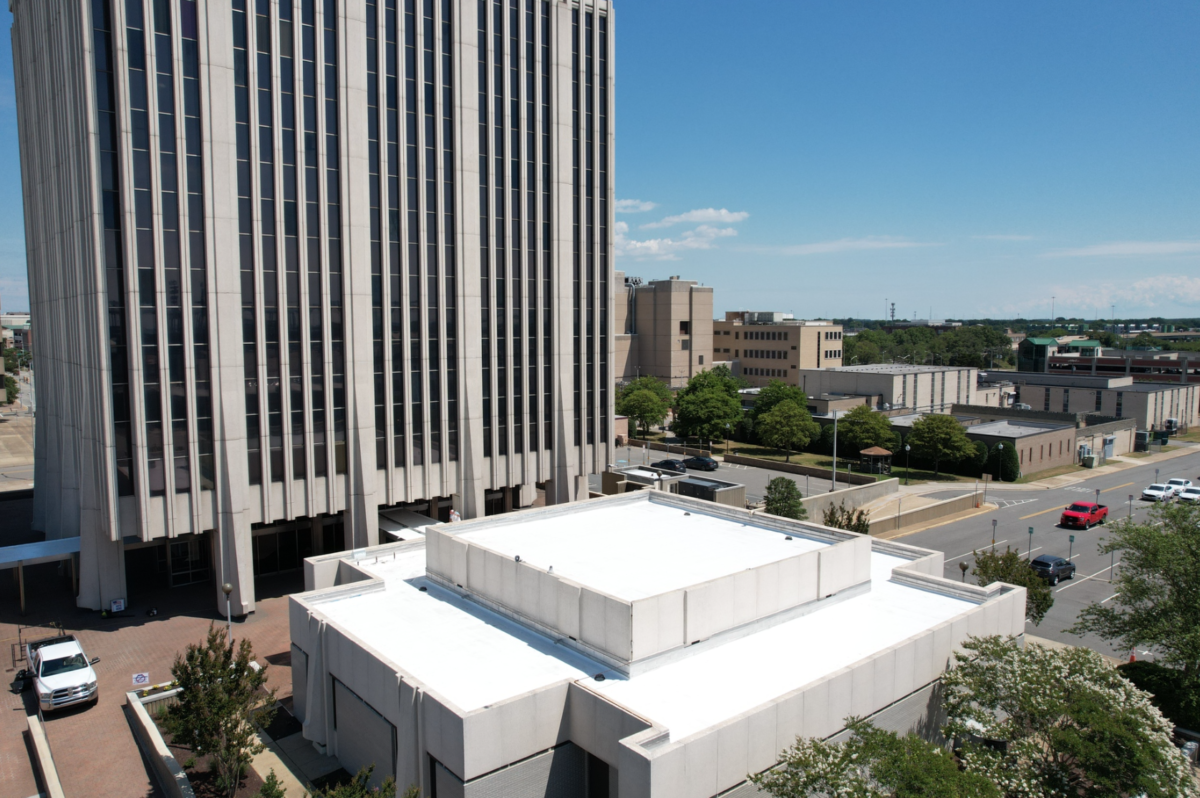
The roofing application was slightly different in those sections as well. “On the walkways, we applied the Soprema base sheet and DensDeck before we applied the coating,” Wilkerson explains. “Previously they were having an issue with the walkways holding water, and raising the level ensured water flowed to the overflow scuppers.”
Final details included Soprema Soprawalk walkway pads, which were adhered using Chem Link’s M1 sealant. The Chem Link E-Curbs system was used for pitch pockets.
A Successful Project
The annex roofs are visible from the main building, and the view is much better with the new system in place. “It’s a great roof, and a great-looking system as well,” says Wilkerson.
He credits the success of the project to Hound Roofing’s experienced and dedicated crew, led by Giovanni Pineda, and great communication with city employees. “The maintenance personnel, engineers, and safety personnel for City Hall were true professionals to work with, and we maintain a great working relationship,” Wilkerson says. “Even when we had the air-handling situation, the City Hall people were great.”
Detailed planning is essential, notes Wilkerson, but so is the ability to adapt as conditions change. “When we have meetings in the morning, I like to say, ‘Now we’ve got good plan to divert from.’ Because every construction project that you do — it doesn’t matter if its new construction or reroofing — you have a basic idea of how things will work, but once you get into it, there’s always a hiccup. We’re just really good at taking care of those things quickly so they don’t become a bigger problem for the customer and our company.”
“Safety is our priority, customer service is our strength, and our field guys are just amazing,” he concludes. “As I said, the hardest project to do is a city hall project because there are just so many eyes on you. If you can pass that test, you can pass any test.”
TEAM
Roofing Contractor: Hound Roofing, Wilmington, North Carolina, and Virginia Beach, Virginia, houndroofing.com
MATERIALS
Coating: Eterna-Seal 7140 and Eterna-Seal 7143, Truco, trucocoatings.com
Base Sheet: Elastophene Flam, Soprema, soprema.us

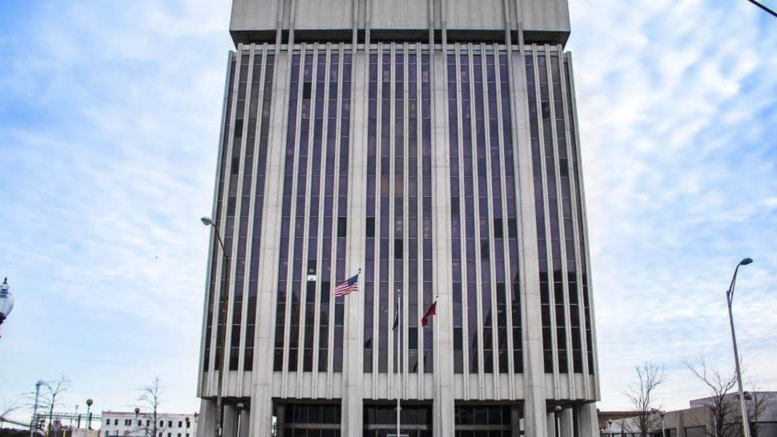


Be the first to comment on "Roof Restoration Project Gives New Life to Newport News City Hall"